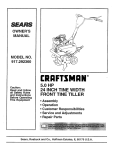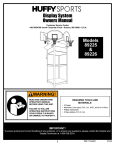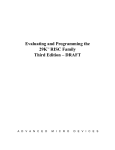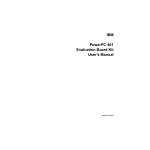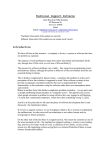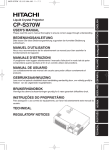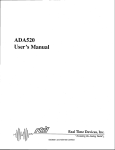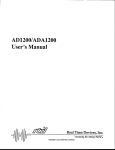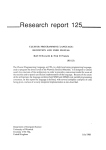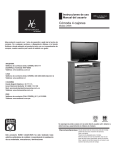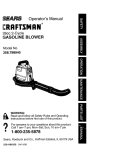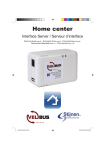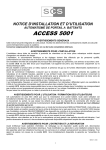Download Setting Interrupt Priorities in
Transcript
Setting Interrupt Priorities in
Soþuare via Interrupt Queueing
Geoff Collyer Bell Laboratories
ABSTRACT: When hardware intemrpt priorities don't
match the needs of software, operating system de'!Ve
signers often just suffer in silence.
describe an
alternative here: simulating the hardware priority interrupt queueing mechanism in software, but assigning
the (software) intemrpt priorities as we wish. This was
done on an AMD 29200 microconffoller [Advanced
Micro Devices 19941 which has effectively only two
intemrpt levels: the clock and ever¡hing else.
@1996 The USENIX Association, Computing Systems, Vol.
9
.
No.
2 . Spring 1996 lI9
I. Introduction
An interrupr is an asynchronous exception or processor trap, typically generated
by a peripheral device to notify the CPU of the completion of some VO operation. This exception typically produces a trap to supervisor (or kernel) mode at
an address reserved for interrupts, and leaves some indication of what caused the
interrupt in the processor state. In uNIxrM-like systems, the first-level interrupt
handler (FLIH) is responsible for saving any machine state that may be altered
and not saved by the C language call sequence, determining the intemrpt's cause,
calling the appropriate C language [Kernighan & Ritchie 1978] interrupt service
routine or intem,qt handler, restoring the saved machine state, dismissing the
hardware intemrpt, and resuming the intemrpted program, so as to make the interrupt transparent. An intemrpt service routine is a subroutine executed in response
to a specific intemrpt. It typically notes the completion of the most recent UO
operation for the device that generated the intemrpt and may initiate the next operation, if one is pending, or it may signal non-intemrpt code that the interrupt has
occurred. The time taken to begin executing the interrupt service routine is called
interrupt re sponse time.
Many computers have an interrupt priority scheme, in which high-priority
devices can intemrpt the service routines of lower-priority devices. Priority is typically determined by hardware, based on some combination of device type and
physical location on the bus (e.g. the DEC PDP-ll family). Some machines (e.g.,
later PDP-11s) [Digital 1976] even have some form of programmable interrupt
request (PIRQ): a means for the operating system to simulate a hardware intemrpt
at a given priority.
A fairly typical
¿urangement of priorities is this: the clock has top priority
and most everything else shares the next priority level down [Ritchie 1979]. For
general use, this is usually fine, but when there is a device requiring very fast interrupt response (or more than one such device!), one would really like to have
such devices get higher-than-normal priority. Devices containing substantial data
buffering generally do not require fast intemrpt response (though it remains desirable), but for devices with little or no buffering, the usual consequence of late
I20
Geoff Collyer
intemrpt response is lost input data or some physical manifestation such as a
ruined CD ROM or flickering video display.
We have implemented software queueing of interrupts within AI&T's
HomeCenterrM, â television set-top box that does not require vast bandwidth to
the home. HomeCenter uses an inexpensive AIN{D 29200 RISC processor with a
single-process operating system borrowing from Plan 9rM [Pike et al. 1990] and
uNIx [Ritchie & Thompson 1978]. Though it runs at t6MHz, our AMD 29200
achieves only about 5 MIPS, largely because it lacks caches and hence is forever
accessing memory. Its register windows can also hurt intemrpt performance if
we need to spill the registers in a service routine. The HomeCenter video interface needs to be refreshed at 60Hz wíth extremeþ fast response to its interrupt
(well under a millisecond). We chose to give up a little performance in exchange
for much faster intemrpt response for a few devices and our choice of intemrpt
priorities.
Register windows are a scheme for using lots of general-purpose registers
that originated at UC Berkeley [Patterson &.Ditzel1980]. The idea is to treat a
large set of general registers as a cache of the stack top. When the stack shrinks
sufficiently to require addressing outside the general registers, the general registers
are filled by copying from the top of the register stack. When the stack grows
sufûciently to require more general registers, the general registers are spilledby
copying them to the top of the register stack.
Software queueing of intemrpts seems to be alluded to in the literature, particularly the older literature lGear 19741, but detailed expositions are lacking. (In
particular, Mach 3.0 queues at most one intemrpt per priority level [they call these
queued interrupts interrupt continuationsl and the objective is greater overall efflciency rather than faster interrupt response [Stodolsky et al. t9931. We would
be unable to provide fast enough intemrpt response using the Mach scheme, since
it masks interrupts once an intemrpt is received during a critical section.) RISC
machines and low-cost microcontrollers may revive this venerable technique.
2. Overview
The idea is to emulate the usual hardware priority intemrpt scheme in software.
Traditionally, processor status words contain a processor level which is the highest
intemrpt priority for which intemrpts are currently being deferred. In HomeCenter,
except for very brief intervals of software-intemrpt queue maintenance, the system
runs with all hardware interrupts enabled at all times.
Setting Interrupt Priorities in Sofruare via Intenupt
Queueing
l2l
As hardware intemrpts are received, they are queued by software priority and
arrival order. They are dequeued and run (by setting the software's virtual processor level or 'VPL' to that in the queue entry and invoking the intemrpt service
routine in the queue entry) by the spln routines [Ritchie 19791 as the VPL drops.
Traditionally these routines are used to protect critical sections of code that manipulate data structures also manipulated by intemrpt service routines.The spln
routines now set the VPL to n, rathet than actually changing the processor level,
to disable only intemrpts at or below priority n. Dequeueing is a bit tricky. In particular, clock intemrpt routines may drop VPL when doing lengthy computations
(e.g., arbitrary time-out callbacks) and may expect to be intemrpted by later clock
interrupts.
3. Caveat
This may all sound straightforward or obvious, but getting the details right is important and may involve intimate knowledge of the hardware. Some years ago, ari
acquaintance with an Interdata 8/32 Unærdata I9761running Interdata's "Edition
Seven" uNIx system asked around to see if anyone could get the unbuffered Interdata UARTs (serial ports) to accept input any faster than 1200 bps (for uucp).
The author implemented a first cut at the scheme described here, which did permit faster UART input but also ruined the Interdata file systems (which had all
been backed up just before the test). Probably lack of familiarity with the Interdata
hardware had caused some subtle point to be overlooked. (The hardware 'helped'
by providing an intemrpt queue.) In any case, this is the only kernel work by the
author (which covers the years from 1978 to the present) that has ever caused file
system damage. Caveat implementor.
4. Implementation
Most devices have a status register containing a ready bit that indicates that the
device is ready to accept a new command. The transition from not-ready to ready
can often be made to generate at least one intemrpt. We assume that all intemrpts
are edge-sensitive: exactly one intemrpt is generated by the transition of a device's
ready bit from not-ready to ready. In some cases we condition the hardware to
make it so. Level-sensitive intemrpts, wherein intemlpts are generated continuously (processor level permitting) while the device is read¡ have not been dealt
with. (They can be handled by having a small device-specifrc routine for each
122
Geoff Collyer
#define
C0NTROLLER
((struct diskregs
*,)0176500)
/* ¡lg: disk interrupts are inhibited while this runs *,/
diskintro
{
struct diskregs 1rP = C0NTRoLLER;
struct diskstate *dp = &disks [rp->unit] ;
nark prevlous tra¡sfer (dp->queue-)head) done;
if
(dp->queue
not empty)
initiate next request on controller rp;
)
Figure 1. Disk intemrpt service routine pseudocode.
level-sensitive interrupt, that turns off that hardware intemrpt, thereby emulating
an edge-sensitive interrupt. Something similar was done in Modula lWirth 1977),
for slightly different reasons.)
A traditional interrupt service routine written in C might look something like
the pseudo-code in Figure 1.
Traditionally, uniprocessor uNIx kernels use elevated processor level to defer
or coalesce intemrpts during critical sections and intemrpt service routines. We
have made the processor level seen by the kernel virtual, with some subtle ramifications described below.
The intemrpt queueing scheme in use in HomeCenter has evolved somewhat.
Initially a single singly-linked queue of intemrpts was maintained, sorted by software priority (in decreasing order) and then by arrival order. This turned out to be
inadequate to provide intemrptible clock intemrpts and was in general fairly costly
and clumsy. The current scheme uses doubly-linked queues: a free queue and a
queue for each software priority. The doubly-linked queues permit fast queue
maintenance in constant time. Figure 2 shows an example snapshot of the inter-
rupt queues.
The code executed in response to a hardware intemrpt must call the common
routine interrupt, with a software priority and intemrpt handler, for each interrupt to be queued, before dismissing the hardware intemrpt. interrupt queues a
representation of the intemrpt:
handler
swpri
flags
serial
the intemrpt service routine's address,
the software priority (redundant since the queue determines priority),
running or not running the service routine currently, and
a unique number used in debugging.
Setting Interrupt Priorities in Sofl-ware vía Intemtpt
Queueing 123
: vÍdeo
:
The DSP is HomeCentor's digital signal processor, ¿n
Figure 2. Example interrupt queues.
LV+
Geoff Collyer
Af,&T
1603 or 1604.
idleo
{
int s = sp10O;
put the processor into a ¡¡ait or idle
splx(s);
mode
until the next interrupt;
)
Figure 3. Usual idle pseudocode.
A queued-intemlpt structure is removed from the free queue, ûlled in and
appended to the queue for this software priority. After queueing one or more interrupts, intrrunqs should be called to service, in decreasing order by software
intemrpt priority, any intemrpts not already being serviced and queued at software intemrpt priority higher than the VPL. intrrunqs is also called by the spln
routines.
intrrunqs
scans the intemrpt queues repeatedly, each time from top
priority
down to one above the current VPL, calling runlintr on the non-empty queue
of highest priority until intrrunqs gets to the current VPL or runlintr finds a
queue with an intemrpt currently being serviced.
runlintr skips any initial queued intemrpts with the RUNNING flag set
and returns with a distinctive return code if there are no other interrupts in this
queue (i.e. at this software interrupt priority). This permits intemrpt service
routines that drop VPL to be intemrpted. If there is a non-RUNNING interrupt in the queue, the flrst such is chosen, its RUNNING bit is set, VPL is set
to the interrupt's software priority, hardware intemrpts arc enabled, and the intemrpt's handler is called. Upon return from the handler, hardware intemrpts
are disabled, VPL is restored, the intemrpt is removed from this queue (and
the structure zeroed to avoid accidents) and the structure is appended to the free
queue.
If
there is a routine called when there is no work to do and to wait for the next
intemrpt, it should be modified to suit this scheme. Our routine (and uNtx's) is
called idle.The usual pseudo-code is in Figure 3. This code will idle the processor
even if there is a queued intemrpt, so we alter this pseudo-code to that in Figure 4.
The whole scheme is a little over-engineered, but caution was considered
wise; see Caveat above.
Running with hardware intemrpts enabled exposes code that expected to compress multiple intemrpts into a single one by running at elevated processor level,
so code may have to be modified to be robust against multiple intemrpts where
Setting Interrupt Priorities in Software vin Interrupt
Queueing 125
idleo
{
int doidle = 0, si
disable interrupts; /* get a consistent view */
if (free-interrupt queue full)
doidle = t; /* nothing queued: ¡¡ait for interrupt */
s = splO0 i /* nn sw interrupts, if any queued *,/
if (doidre)
I
put the processor into a wait or idle node u¡til the next interrupt;
sptx(s);
restore interrupts;
Figure 4. Revised idle pseudocode.
previously only one was possible.
One also needs to beware of ill-behaved devices (e.g., attached processors)
whose intemrpt service routines drop software 'processor level': a flurry of inteffupts can grow the (kernel) stack enormously. We have found it necessary to
quickly dismiss all but the first of a series of intemrpts indicating that some status
bit is (spuriously) flipping on and off rapidly.
Thus, in HomeCenter, pseudo-code for the above-cited disk intemrpt would be
more like Figure 5 (including pseudo-code for the intemrpt queueing).
runlintr(q)
struct intrq 'tq;
{
struct qdintr *qi = q->head;
if (qi
== 0)
return 1;
remove qi fron q;
set VPL to qi->swpri;
enable interrupts;
(*qi->haadler) O;
disable interrupts;
restore VPL;
pìrt qi on the free queue;
return 0;
Ì
Figure 5. Revised disk intemrpt pseudocode. (continued on next page)
126
Geoff Collyer
intrruaqso
{
struct intrq *q;
do{
Ì
q=0;
scan interrupt queues fron highest to lowest priority
(Wf) an¿ select a non-empty queue, q, if any;
Ì while (q != 0 && runlintr(q) == 0);
interrupt(pri,
int pri;
haadler)
voÍd (*handler) O;
{
struct intrq *q = intrqs[priJ;
struct qdintr *q1;
qi fron free queue;
if (free queue exhausted)
remove
panlcO;
qi->swpri = pri;
qi->haadler = ha¡rd1er;
add
qi to
q;
Ì
#deflne
C0NTROLLER
((struct diskregs,t)0176500)
å:."r.irrt.rorLo
{
struct diskregs arP = CoNTRoLLER;
struct diskstate *dp = &diskslrp->unitl;
nark prevlous transfer (dp->queue->head) done;
if
(dp->queue
not enpty)
initiate next request on controller rp;
Ì
diskintro
{
interrupt (Diskpri, disklntr¡rork)
intrrunqsO;
;
Ì
Figure 5. (continued) Revised disk intemrpt pseudocode.
Setting
Intetupt Priorities in Software via Intemtpt Queueing L27
runlintr(g)
struct intrq *q;
{
(
*qÍ->ha:rdler) (qi->ctrlr)
;
Ì
interrupt(pri, handler, ctrlr)
int pri, ctrlr;
void (*handfer) O;
{
qi->swpri = pri;
qi->handler = handler;
qi->ctr1r = ctrlr;
add
qi to
q;
)
rtr )
int ctrlr;
{
struct diskregs *rp = C0NTROLLER[cIrIr];
di ski.ntr¡¡ork ( ct
)
diskintr(ctrlr)
int ctrlr; /* from FLIH */
{
interrupt(Diskpri, diskintrwork, ctrlr)
intrrunqsO;
;
Ì
Figure 6. Projected disk intemrpt pseudocode.
HomeCenter is unusual in having only one of each peripheral; general-purpose
computers are likely to, at least potentially, have multþle device controllers of
the same type (e.g., serial ports). In such cases, the FLIH generally provides an
argument to the intem¡pt handlers containing the number of the controller interrupting. To accommodate multiple confiollers, we would need to add a 'controller'
argument to interrupt, the queued-intemrpt structure (qdintr) and the intemrpt
handlers as in Figure 6.
128
Geoff Collyer
5. Bonuses
With this scheme in place, several features fell out fairly naturally. A video interface requiring very fast response, but very simple processing, was dealt with by
avoiding the intemrpt queue altogether, and just calling its intemrpt service routine
directly from interrupt.
A programmable intemrpt request (PIRQ) facility also fell out. This is used
to perform soffi,vare refresh of DRAM at middling intemrpt priority. Normally
hardware aranges to refresh DRAM (which will decay if not read roughly every
8 ms.) transparently, but in our case the hardware refresh of the 29200 produces
occasional video glitches (part of a scan line turns white), so we turn off the
hardware refresh and simulate it, at some cost (5Vo of the CPU per megabyte of
DRAM refreshed), in software.
6. Costs
There is obviously additional CPU overhead to queueing intemrpts and there is
memory associated with the queue, which must be large enough to accommodate
infrequent surges. The spln routines must scan the intemrpt queues when 'processor level' drops, but this is quick. One would not use this technique were the
hardware intemrpt priorities appropriate to the task at hand, but in the absence of
such hardware,
it
has its uses.
7. Conclusion
Software intemrpt queueing costs a little overhead, but frees system designers from
bad choices of hardware intemrpt priorities and provides other benefits, such as a
programmable intemrpt request facility. Careful implementation yields a system
which needs little modification to device drivers while meeting unusual needs easily.
Acknowledgments
Henry Spencer, Mark Moraes and three anonymous reviewers critiqued drafts of
this pape¡ improving it thereby. Bary Shein helped me search the databases of
USENIX papers. Dave Sherman allowed me to experiment with my first cut of
this technique on his Interdata machine.
Setting Interrupt Priorities in Sofauare via Interrupt
Queueing I29
References
1.
Advanced Micro Devices, Am29200 and Am29205 RISC Microcontrollers (Jser's
Manual,1994.
2.
3.
Digital Equipment Corporation, pdpll/70 processor handbook, 1976.
C. V/illiam Gea¡ Computer Organization ønd Programming, 2nd ed.,McGrawHi]J (1974).
4.
5.
Interdata Inc, Model 8/32 Processor User's Manual, January 1976.
B. V/. Kernighan and D. M. Ritchie, The C Programming Innguage, Prentice-Hall,
Englewood Cliffs, New Jersey (1978).
6.
A. M. Lister, Fundamentals of Operating Systems, Second Edition, Macmillan (1979).
D. Patterson and D. R. Ditzel, The Case for the Reduced Instruction Set Computer, Computer Architecture News 8(7) (1980).
7.
8.
9.
10.
11.
Rob Pike, Dave Presotto, Ken Thompson, and Howard Trickey, Plan 9 from Bell
Labs, Proc. of the Summer 1990 UKUUG Conf., London, pages 1-9 (July, 1990).
D. M. Ritchie and K. Thompson, The UNrx Time-Sharing Sysrem, Bell Sys. Tech.
J.57(6), pages 1905-1929 (1978).
Dennis M. Ritchie, The uNx VO System, UNIX Programmer's Manual, Seventh
Edition (J anuary, 197 9).
Daniel Stodolsky, J. Brad Chen, and Brian Bershad, Fast Intemrpt Priority Management in Operating System Kernels, pages 105-110, Microkernels and Other
Kernel Architectures Symposium 1¿ USBNIX, San Diego, CA (Sept. 20-21,1993).
12.
130
N. Wirth, Design and Implementation of Modula, Sofnuare-Practice & Experience 7, pages 67-84 (1977)-
Geoff Collyer












